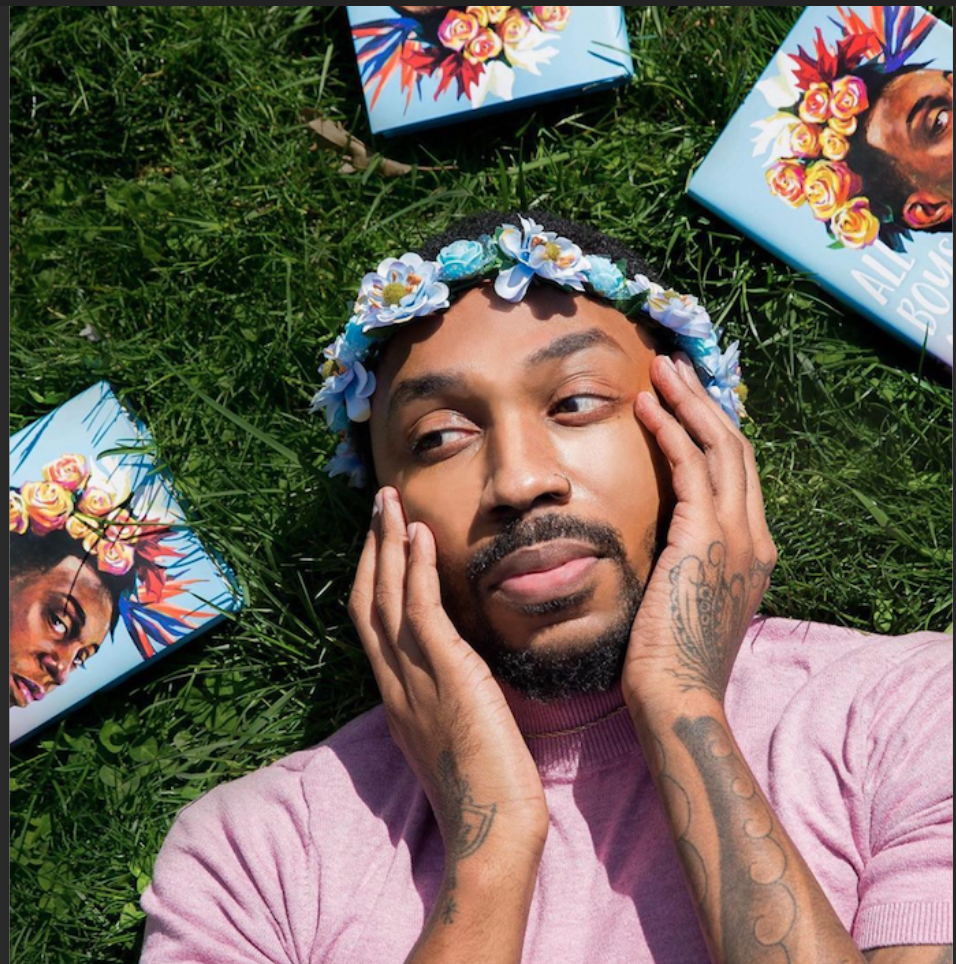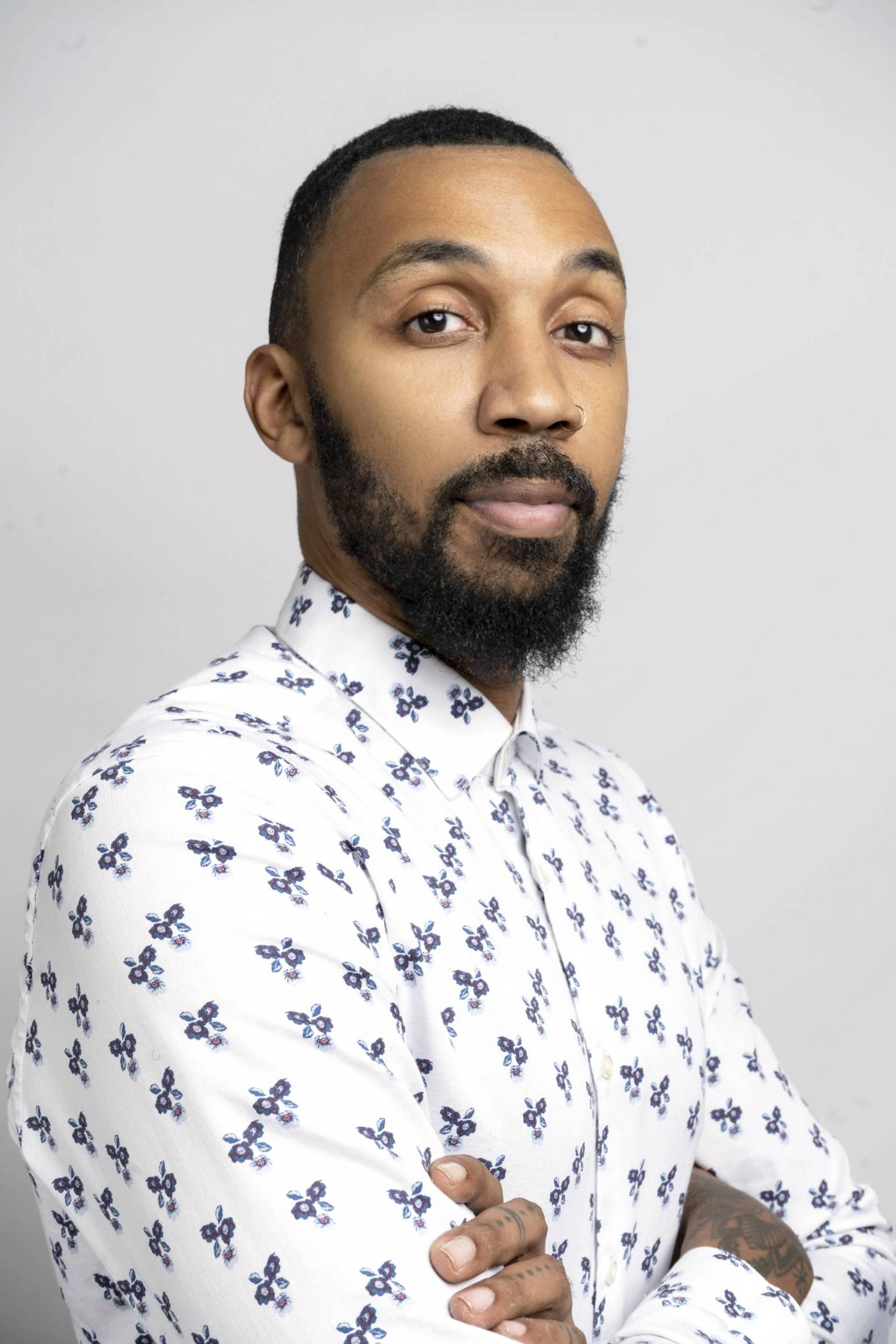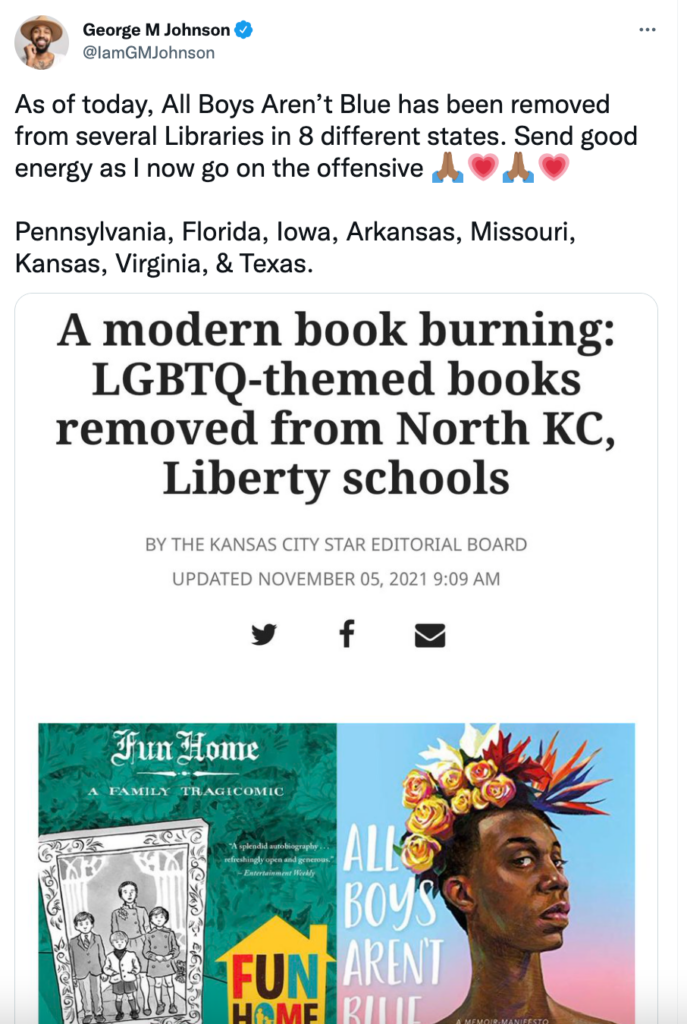By Kellee Terrell
As conservatives continue to peddle out their newest hot-button issue—”Critical Race Theory”—it’s had an infuriating and swift impact on all people living in this country. Over the past few months, laws have been passed in states and counties that make it illegal for teachers to teach any history that tells the truth about white supremacy and hatred’s impact on communities of color and LGBTQI+ people. To further this archaic agenda, school districts and public libraries have also brought back book banning, ensuring that young people cannot check out diverse classics such as Toni Morrison’s Beloved, Robert Coles’ The Story of Ruby Bridges, and Angie Thomas’ debut novel The Hate U Give.
One author caught in the Right’s ideological crosshairs is non-binary author George M. Johnson. Their award-winning YA memoir All Boys Aren’t Blue has become the number one banned book in the U.S., with eight states, including Iowa, Florida, and Missouri, taking it off public school shelves. Critics have accused the Amazon Best Book of the Year, Indie Bestseller, People Magazine Best Book of the Year of being “pornographic.” One Florida woman even filed a criminal complaint against the book and Johnson last November. But in reality, the book couldn’t be further from its detractors’ claims. Dubbed a young adult “memoir-manifesto,” this fearless collection of “stories through essays” explores this little Black boy from Plainfield, New Jersey, who at an early age knew they were “different.” With each page, readers travel back in time with Johnson on this moving journey of self-discovery, self-love and, eventually, joy.
Lambda Legal sat down with the New York Times best-selling author to talk about what inspired All Boys Aren’t Blue, the dangerous messages banning books sends to Black and queer youth, and the importance of writing themselves into freedom.
Kellee Terrell: Before we get into book banning, can you please tell us about All Boys Aren’t Blue?
George M. Johnson: Sure! All Boys Aren’t Blue is a love letter to the Black experience and the Black family dynamic and a coming-of-age story about a journey through Blackness and queerness. It showcases what it feels like when you grow up being Black and question whether you’re heterosexual or non-heterosexual and don’t have any representation or certain cues to pull from socially. So, you navigate the world haphazardly, making many mistakes along the way. Even though I was struggling growing up, I had a family who still loved, affirmed me, and allowed me to be myself, even when I didn’t know what I was at that time. My book is also a realistic journey about how queer people don’t always exist in a world with only queer people—we exist with heterosexual people and vice versa.
KT: It’s also a love letter to your grandmother, Nanny. Why was telling her story so important?
GMJ: Yes, Nanny! She was this pistol from the South who was very caring and big on instilling the principle that if you’re blessed, you’re supposed to bless others. Telling her story was so important. She was really the change agent, not just in my life but in the lives of my family and those in the community. She was the baby of her family but took on the role of raising kids: Hers, family members’ including grandkids and adopting a nephew, and 24 foster kids for the state of New Jersey. She was my first hero and was a caregiver at heart—sometimes to her own detriment and at the expense of taking care of herself—but she truly loved others.
Looking at sexual orientation and gender identity, she always operated from a place of love. Even as she watched my trans cousin transition, she may not have fully understood what it meant or had the language to talk about it, but she knew that even if the world didn’t accept it, she accepted it. In turn, my cousin and I always knew we had a place to call home. So, this book honors her by giving back to others on a much larger scale.
KT: These are the types of stories we need, especially given the persistent stereotypes that Black people are the ‘most homophobic” and are “more likely to turn their backs on their LGBTQI+ children.” All Boys Aren’t Blue is proof that you can be a Black queer person and your family can love you.
GMJ: Absolutely. Stories like this one are so important because, as Black people, we’re indoctrinated to hate anything that is non-heterosexual. I was like that too–it’s just part of our conditioning. People need to read All Boys Aren’t Blue and books like it because it showcases that we all live among one another and that the denial of my existence only harms our overall community because we are all in community together.
Most importantly, my book—at its heart— showcases that my family just nurtured people—not just the people they were trying to make us be. Deciding to have a child shouldn’t be about making that child be what you want but more about nurturing the child you’ve been given. More parents have to understand that their children are not replicas or extensions of you in the world. Instead, they are individual people who need you to guide them to what they’ve naturally gravitated to and nurture and protect whoever they are without shame.
KT: While the book also delves into topics about sex, sexual abuse, consent, and sexuality, this book is not the “graphic porn” your detractors claim it to be. Did you ever imagine this type of national pushback would happen to a book that’s essentially about love, family and empowerment?
GMJ: I always knew, at some point, it could happen, but I never thought it would have sparked a nationwide argument or have criminal complaints filed or efforts to enact laws against it. I never thought there would be this much chaos and danger where people would show up to school board meetings with guns. Yet here we are, 17 months after my book came out, and eight states have banned All Boys Aren’t Blue.
It first started when I found a post on Facebook from a guy running for school board in Kansas City, Missouri, who wrote this whole long, nasty post. So I quoted over the post by making a joke, and he eventually deleted it because I brought a bunch of attention to it. After, I sat back and watched, and then it became a national story, and then a lady in Florida filed a criminal complaint against me and the book. That really sent everything into high gear, and I knew I was going to fight.
KT: Book banning most definitely plays into the Right’s newest dog whistle—”Critical Race Theory”—but what else do you believe is at play?
GMJ: Every two to three years in America, they pick a new hot button issue to rally their base for six to eight months. Then, midterm elections happen, and they switch to something else they feel is more important. But for right now, we’re just kind of in the middle of a battle around anti-LGBTQ beliefs and LGBTQ erasure, specifically Black erasure and experiences in this nation’s school systems. Honestly, this also stems from the fact that Gen-Z is the most diverse population in the country: 52 percent is white, and 48 percent is nonwhite. This is the first time we’ve ever gotten this close to a generation where white people could be outnumbered. Also, 15 percent of Gen-Z identifies as queer, and it’s growing each year.
So, if the goal is to attack Gen Z, they have to go to the place where they have indoctrinated minds for hundreds of years in this country—the school system. But, they also know that storytelling has been the strongest tool to change hearts and minds and inspire the next generation of leaders. Growing up, I was taught that Abraham Lincoln was my savior and read Catcher in the Rye, To Kill a Mockingbird, and the white canon. Meanwhile, my cousins are being taught about heroes that look like them and reading books like The Hate U Give. This newer generation is being indoctrinated with real stories and real experiences. So much, so that nonwhite kids fully understand the world’s misery, racism, and queerphobia. Even white kids growing up in conservative homes, but go to schools where they’re reading these texts, are starting to develop a different mindset than their parents. Go to Tik Tok; white kids are airing out their Republican parents. But this demographic and ideological shift is a critical fear, and now white people are making their last-ditch effort to stop it at all costs.
KT: What are the other dangers of banning books?
GMJ: Whether it’s book banning, Florida’s “Don’t Say Gay” bill, or Texas Gov. Abbot threatening to send parents to jail for allowing their trans children to transition, we are telling our youth that their existence, experiences, and safety don’t matter. And when we tell them they don’t have the right to read about people who exist in this world like them, what we’re really saying is that they should not exist in this world and that their oppression and their ancestor’s oppression aren’t real and don’t matter. That is dangerous.
KT: What can we all do to ensure that books don’t get banned in our communities?
GMJ: If you live in a community where they’re banning books or threatening to, please go and buy those books. You can donate them to public libraries, other organizations, or teens that need them. Also, read them for yourself and leave a personal testimony about how these books made you feel and how they helped you see the world. It’s much harder for a school board to say, “We’re going to remove this book because two parents are upset,” if you have 100 parents or 100 students say, “No. This book changed my life.” Because unfortunately, right now in this country, the person who speaks the loudest sometimes is the victor. But that’s also why I choose to speak the loudest because in doing so, it makes it much harder for them to push back.
KT: Finally, we talk a lot about “speaking truth to power,” but there’s also this idea of “writing yourself into freedom.” What does that mean for you?
GMJ: For me, it’s about creating a Black and LGBTQ-specific canon where no one has to be the 10-year-old, 15-year-old, and even 20-year-old I was and not understand who they are or see themselves on the page. I don’t want them to have to go through what I did. But writing myself into freedom also means freeing myself and the inner children that live in me by writing the texts they didn’t have.





